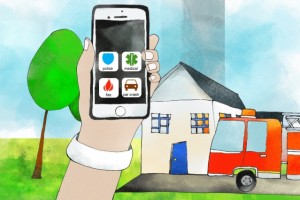Mobile app automatically sends a caller’s location and medical data to dispatch centers.
RapidSOS, a startup with MIT roots, is gearing up to release a one-touch 911 app that automatically sends location and preset medical data from a smartphone to dispatch centers, with aims of drastically reducing the time it takes first responders to get to a scene.
According to the Federal Communications Commission (FCC), around 70 percent of 911 calls today are made via mobile phones. Yet when fielding such calls, dispatchers rely on landline-based systems that sometimes fail to pinpoint a mobile caller’s location quickly or at all during time sensitive emergencies Experts have estimated that 60 percent of 911 calls come through with inaccurate or no location data.
The problem happens when calls to 911 are made from a cell phone inside a building. Cell phone signals are strong enough to go through thick, concrete walls, but 911 dispatchers rely on GPS signals which are weaker and have a higher frequency and can bounce back.
Only the address of the cell tower shows up, that can be miles, literally, away from where the caller is calling from. Every minute counts in true emergencies. More than 6,000 emergency dispatch centers across the United States are using computer-aided dispatch (CAD) systems developed in the 1960s and 1970s. These systems primarily use cell tower triangulation to determine a caller’s location. But this isn’t very accurate, and sometimes calls drop before the system gets fixed coordinates
The phone call will always go to the dispatch center the cell tower is connected to and when you end up at the wrong center, they don’t have the radio system or maps to find out where you are, so they need to connect to a local dispatch center that knows.
This could take several minutes. If you call from, say, the MIT campus, you’ll automatically be directed to the state police in Framingham. Once you say you’re in Cambridge, your call will be transferred to a dispatch center in Kendall Square to further explain your location and situation.
RapidSOS, has a one-touch 911 app that automatically sends location and preset medical data from a smartphone to dispatch centers, with aims of drastically reducing the time it takes first responders to get to a scene.
The “driving force” behind RapidSOS is insurance agencies, as advanced location services could save billions of dollars in hospital bills and other expenses, such as damages caused by house fires.
This data is routed to RapidSOS servers, which patch it through to the nearest emergency center.
If the phone dies or service is interrupted, RapidSOS maintains the connection and keeps uploading updated location information. Users may also send texts to dispatch centers universally, today only to a limited number of U.S.
Dispatch centers can receive texts. Loved ones also receive emergency alerts.
All information pops up on the CAD software the same as incoming calls, so no new equipment or training is required.
Users can also set the app to automatically power the phone’s camera to stream video to the RapidSOS servers.
Having tested the app in dispatch centers across the United States, RapidSOS is releasing its commercial app in December. Individual consumers may download the app
In future, the core technology could be used for home alarm systems or to develop a “panic button” for use at convenience stores, banks, or teachers’ desks to get an
“Accurate picture” of the location.
Today only around 12 percent of dispatch centers have systems that can accept video, but RapidSOS is working on making live streaming video part of any 911 call.
For more information please visit: www.news.mit.edu


Comments are closed.